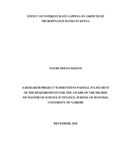| dc.description.abstract | The question of whether shifts in interest rates affect the growth of firms has been widely examined in both academic and policy circles and there are proponents and opponents of interest rate capping. Proponents argue that the introduction of interest rate ceilings protect the public interest through ensuring a reasonable and fair interest rate advanced on loans. Alternatively, opponents argue that financial liberalization results to potential gains in terms of efficiency in investment resources’ allocation. The aim of this study was to ascertain the effect of interest rate capping on growth of microfinance banks in Kenya.
The population for the study was all the 11 microfinance banks operating in Kenya as at December 2017. The independent variables for the study were Interest rate capping as measured by a dummy, asset quality as measured by the ratio of non-performing loans to total gross loans, liquidity as measured by the ratio of liquid assets to short term liabilities and capital adequacy as measured by the ratio of core capital to total capital deposits. Growth of microfinance banks was the dependent variable and was measured by profitability, customer deposits and loan book value. Secondary data was collected over a period of 10 quarters (5 quarters before interest rate capping and 5 quarters after interest rate capping). The descriptive cross-sectional research design was employed for the study and the relationship between variables established using multiple linear regression analysis. Data analysis was undertaken using the SPSS software. The results of the study produced R-square values of 0.452, 0.331 and 0.383 for profitability, customer deposits and loan book value respectively. This implies that the selected independent variables (interest rate capping, capital adequacy, asset quality and liquidity) explains 45.2%, 33.1% and 38.3% of profitability, customer deposits and loan book value of microfinance banks respectively. The remaining percentage is explained by other factors not covered in this research. ANOVA results show that the F statistics were significant at 5% level with p values of 0.000 for all the three regression models. Therefore the three models were fit to explain the association between the selected variables. The findings also showed that firm liquidity and asset quality have a significant effect on profitability of microfinance banks, asset quality has a significant effect on customer deposits while liquidity, asset quality and capital adequacy have a significant effect on loan book values. Interest rate capping was found to be an insignificant determiner in all the three models as shown by high p values. This study recommends that when policy makers are considering repealing of interest rate capping due to its negative effect in the economy, profitability, customer deposits and loan book value of microfinance banks should not be a reason to repeal as they are not significantly affected by interest rate capping | en_US |



